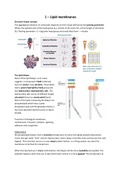1 – Lipid membranes
Structure-shape concept
The aggregation behavior of surfactants depends on their shape defined by the packing parameter.
Where the optimal area of the head group (ao), volume of the chain (V), critical length of the tether
(lc). Packing parameter <1 = big polar head group and small alkyl chain → micelle
The lipid bilayer
Most of the lipid bilayer, as its name
suggests, is composed of lipid molecules
that can anchor many proteins. These lipids
have a polar (hydrophilic) head group and
two hydrocarbon (hydrophobic) tails. The
hydrocarbon tails can be of different length,
saturated (linear) or unsaturated (bent).
Most of the lipids composing the bilayer are
phospholipids which have a polar
phosphate head and Phosphatidyl choline is
the most abundant lipid (structure in figure
beside).
Functions of biological membrane:
confinement, transport, catalysis, signaling,
adhesion and recognition.
Organization
All phospholipid bilayers have a transition temperature at which the tightly packed hydrocarbon
chains (the gel state) “melt” and the hydrocarbon chains adapt a fluid like state and become less well
aligned. This transition occurs in a very steep/sudden fashion. In a living system, you want the
membrane to be fluid for interactions.
When the lipid tails are in trans conformation, the bilayer will be more crystalline and packed. The
opposite happens when they are in cis conformation where it is more gapped. The temperature at
,which the bilayer becomes fluid depends on the length of the alkyl chain. Longer alkyl chain results
in a higher melting point (more gel-like). Furthermore, the more double bonds (unsaturated) the
fatty acid chain is, the quicker it gets melted (lower melting point).
Composition
Cell membranes contain several types of
lipids which can affect the affinity of
membrane proteins and flexibility of
the membrane. Hence, lipid
composition is locally tuned to perform
the functions of the membrane:
1. Compartmentalisation of cell
components
2. Immobilization/support of
biomolecules required for
communication and transport
Glycerophospholipid has a phosphate
group which is connected to the glycerol
(triol). The glycerol is connected to 2
fatty acids.
Sphingolipid does not contain any
glycerol, instead, it has sphingosine
(18-carbon amino alcohol with an
unsaturated hydrocarbon chain) as a
connecting group. It has only 1 fatty
acid.
Cholesterol keeps the membrane at the right stability and fluidity. It is characterized by its sterol
center of hydrocarbon rings, the hydrocarbon chain, and the -OH group.
The lipid membrane is asymmetric. The composition of the inner leaflet is different from the outside
to assert different functions. For example: phosphatidylserine is only present on the inside,
glycolipids (containing sugar head groups) are only present on the outside. Proteins can be attached
to the outside of the membrane, but also be embedded inside the membrane.
Movement of lipids
The bilayer is a fluid organelle. Lipid molecules can move around (lateral diffusion) and rotate about
their long axis. They almost never cross over from one lipid monolayer to the other (flip-flop) as it is
thermodynamically unfavorable for them to cross the hydrophobic inner part. However, in the case
of lipid synthesis inside the cells, there are specific proteins that facilitate flip-flop to the outer side.
Fluidity is controlled through lipid composition:
1. Fatty acid chain length: shorter → more fluid
, 2. Number of double bonds: more double bond → more fluid
3. Cholesterol: presence of cholesterol stiffens the
membrane by packing in between unsaturated
C-H tails.
There are rigid patches present in the fluid matrix of
the lipid membrane called lipid rafts. These are rich in
sphingolipids and cholesterol. Sphingolipids normally
have longer saturated hydrocarbon tails which makes
them thicker.
Liposome
A liposome is a closed lipid bilayer that contains a volume of water. The sealed compartment is
formed because it is more energetically favorable. In the lab, we
can make artificial liposomes from dry lipid films. Upon hydration,
they start swelling and repel each other, coming loose. They will
then form multilamellar vesicles. Then, energy is given through
sonication and these multilamellar vesicles form small unilamellar
vesicles.
Visualization
- Transmission electron microscopy (TEM) of
nanostructures: like a normal microscopy, TEM has a
sample slide, lenses, light source, viewing screen, electron
beam. The sample is put on a thin film grid of
carbon/polymer. It is then stained to increase contrast
against the grid. There is also a high vacuum to dry the sample. However, drying changes
concentration and temperature which compromises visualization. Staining causes
aggregation.
- CryoTEM: this is a method of imaging in the hydrated state. Firstly, we dip the sample into
water to create a thin film. Water is needed to rapidly freeze the sample. The thin film is
dipped in liquid ethane which can crystallize the sample so fast that everything is fixed in
place then imaging is done.
Electrons however, can destroy the specimen.
- CryoElectron tomography (3D TEM): first, the sample is captured from multiple angles. Then
using a program, we reconstruct the 3D volume followed by image alignment. This allows
counting of proteins to determine binding efficiency of proteins with the vesicle since you
can’t distinguish proteins stuck and proteins swimming.
Application
Since liposomes have a hydrophilic and phobic compartment, they are able to carry
hydrophilic/phobic drugs. Liposomes can be made stable in the blood by attaching poly(ethylene
glycol) chains which allow them to evade the immune system.




